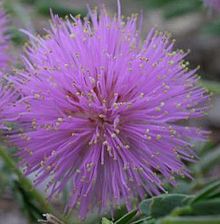| This article needs additional citations for verification. Please help improve this article by adding citations to reliable sources. Unsourced material may be challenged and removed. Find sources: "Mimosa borealis" – news · newspapers · books · scholar · JSTOR (January 2019) (Learn how and when to remove this message) |
| Mimosa borealis | |
|---|---|

| |
| Mimosa borealis flower | |
| Conservation status | |
 Secure (NatureServe) | |
| Scientific classification | |
| Kingdom: | Plantae |
| Clade: | Tracheophytes |
| Clade: | Angiosperms |
| Clade: | Eudicots |
| Clade: | Rosids |
| Order: | Fabales |
| Family: | Fabaceae |
| Subfamily: | Caesalpinioideae |
| Clade: | Mimosoid clade |
| Genus: | Mimosa |
| Species: | M. borealis |
| Binomial name | |
| Mimosa borealis A.Gray | |
| Synonyms | |
| |
Mimosa borealis, the fragrant mimosa or pink mimosa, is a plant in the family Fabaceae. It is found from Oklahoma to Kansas and south-eastern Colorado, south through central and western Texas and New Mexico to Mexico. The habitat consists of rocky hills, canyons and brushy areas. The plant has a height around 3 feet (90 cm). The flowering phase of the plant is between spring to summer.
References
- NatureServe (2024). "Mimosa borealis". Arlington, Virginia. Retrieved 20 July 2024.
- "Mimosa borealis A.Gray". Plants of the World Online. Royal Botanic Gardens, Kew. Retrieved 20 July 2024.
- "Lady Bird Johnson Wildflower Center - The University of Texas at Austin". www.wildflower.org. Retrieved 2019-04-09.
- "Plants of Texas Rangelands » Fragrant mimosa". rangeplants.tamu.edu. Retrieved 2019-04-09.
- "Mimosa borealis (Fragrant Mimosa)". World of Flowering Plants. 2014-06-26. Retrieved 2019-04-13.
- "Texas Native Plants Database". aggie-horticulture.tamu.edu. Retrieved 2019-04-13.
 Media related to Mimosa borealis at Wikimedia Commons
Media related to Mimosa borealis at Wikimedia Commons
This Mimosoideae-related article is a stub. You can help Misplaced Pages by expanding it. |